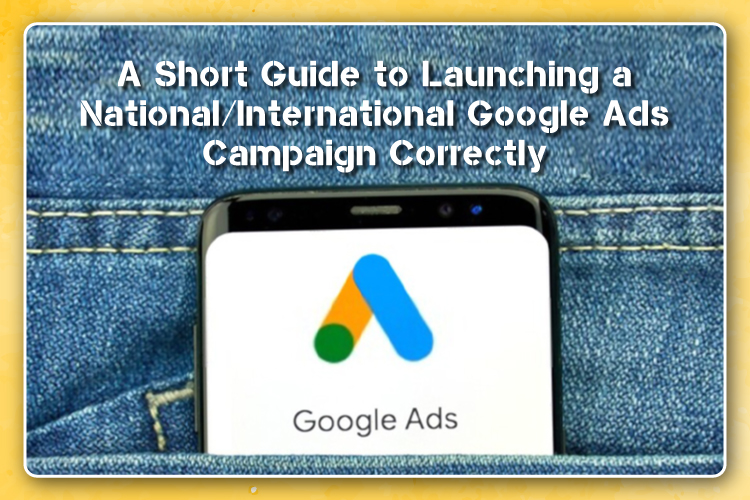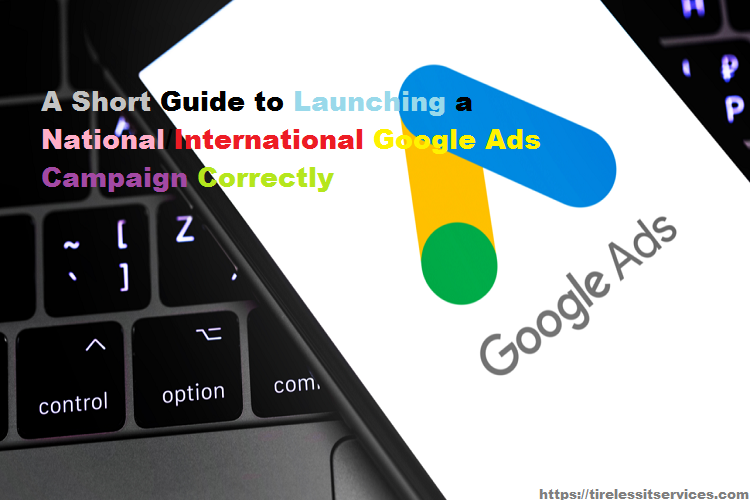A Short Guide to Launching a National/International Google Ads Campaign Correctly

Launching a fresh new ad campaign is thrilling as it could involve trying out a new strategy, platform, or even market!
That being said, new campaigns are costly too. They can be volatile as they get over the learning phases.
At times, account managers will invest copiously in the initial periods to dodge the learning phases, which means the return on ad spend (ROAS) will be lesser.
Suppose you want to launch a B2B Google Ads campaign that appears globally. It is highly advisable that you begin with limited locations. Start with a single market to test your ads and keywords and prove your ROAS, strategies, etc. And then, later on, you can expand to additional locations.
Typically, all ad campaigns need anywhere between 2 to 4 weeks at the minimum to get ramped up. At that point, you can then evaluate if you’ve got a winning strategy to implement in other markets.
In this blog, we will discuss everything you need to know to launch national/international Google Ads campaigns in the right way.
NATIONAL/INTERNATIONAL CAMPAIGNS: RULES OF ENGAGEMENT
National/International campaigns have very particular rules of engagement. These are as follows:
- Accounting for market nuances in the way users think or search
- Market demand for various products or services
- Regulatory considerations
One can quickly fall into the trap of making a campaign overly complicated simply because it’s “business.” But what “really” matters is that the basics are well-grounded.
Long story short, begin with a single market, prove your path to scale, strategies and ROAS and then expand to other geographical locations eventually.
BASICS: BUDGETS, CAMPAIGN SETTINGS, AND MORE
The success or failure of a campaign depends on its settings to a great extent. If you target multiple geographical locations in one campaign, you attract the following risks:
- Budget allocation is determined by the highest search volume rather than profitability.
- Ad delivery could be low because of time-zones being set at the account level.
Generally, it is advisable to limit campaigns to a single time zone only. This helps ensure the accuracy of ad scheduling (dayparting) and that the ad budgets are not pushed to cater to too many markets.
In fact, some businesses prefer to create a different ad account for each country (mainly if a notable currency is not available in a stated country).
Based on the individual company, this is either a critical step because of the unstable exchange rates or merely an organizational choice.
On the contrary, certain features such as household income and specific extensions are available in a few countries only.
You will want to take time zones and currency into account to cash in on particular markets (like the US) where the features rolled out before time.
MARKET DEMAND AND NUANCES
When it comes to performing keyword research, Google Trends stands as one of our outright favorite free tools available in the market.
It lets you view trends and volume for search terms by geographical location over time.
One of the most common yet biggest mistakes seen in the new accounts is that they run proven ad campaigns in new markets without making adjustments for how that particular market thinks or searches.
Even two similar keywords like marketing tools and marketing software have pockets of influence. And these nuances are all the more crucial in B2B as the auction prices tend to be overly high.
Launching ad campaigns in multiple countries calls for more than merely using Google Translate for translating winning keywords.
The meaning is most often not entirely correct, and you will end up blowing valuable marketing bucks on terms that don’t even add up.
It might be quite enticing to use the extremely flexible close variants or match types to justify performing careless translations. But you will get a far better ROI when you invest in a native translation of ads, keywords, and landing pages.

CREATIVE CHOICES PLAY A VITAL ROLE
Simply because a campaign works wonders in one market does not mean it will necessarily rock all the other markets.
Let’s say leading with questions and using language that addresses the user works well in your domestic market. Now you shouldn’t implement this on your campaigns for other markets without experimenting against different innovative strategies first.
To put things into perspective, let’s look at an example. In the US, people are more inclined towards a cleaner design and want the landing page to guide them to the conversion action.
On the other hand, in Japan, the landing page can be a bit more crowded (primarily if it makes way for more trust symbols).
Implementing either landing page layout blindly to the other market would result in your campaign failing.
Take out some time to perform an A/B test on creative choices and research the latest design trends in the market you are planning to enter.
REGULATORY CONSIDERATIONS
Undoubtedly, digital marketing would have been way more straightforward if all of us lived under the same set of laws.
What classifies as illegal in one market might be 100% legal in another, meaning that advertising eligibility may vary in different markets.
Before you launch a campaign, make sure you have verified whether or not a market permits advertising on the platform you are looking to run your ads on.
For instance, suppose you want to advertise a betting app. In some markets, you would have restricted advertising eligibility with certifications, but it may be entirely prohibited in others.
Even though different markets will differ in eligibility criteria, they are unified in privacy protections. Compliance with GDPR, CPPA, and other laws alike is essential for advertisers if they want to steer clear of crippling violation penalties.
This is mainly necessary as the cookie deprecates, and we are more dependent on email accumulation.
Privacy policies need to be a significant ingredient in a landing page design or theory (as against a disposable footer).
WRAPPING IT UP
Rolling out Google Ads campaigns in new markets calls for research and adjustment, mainly when they comprise numerous locations. This makes it essential for you to ensure that your strategy is on point.
Instead of launching campaigns in multiple markets at once, utilize the ramp-up phase to carry out the legwork for the next geographical location.
Doing so will help make sure you invest the 2-4 weeks (at the minimum) your upcoming campaign deserves.
Nevertheless, make sure your legwork incorporates:
- Proper keyword research to account for various search trends and patterns
- Creative adjustments for landing pages and ads
- Legal and compliance considerations according to location
That was all you needed to know about this. Be sure to keep this short and quick guide in mind when planning to launch your next (new) national/international Google Ads campaign, and you’ll be all set to go!
Hariom Balhara is an inventive person who has been doing intensive research in particular topics and writing blogs and articles for Tireless IT Services. Tireless IT Services is a Digital Marketing, SEO, SMO, PPC and Web Development company that comes with massive experiences. We specialize in digital marketing, Web Designing and development, graphic design, and a lot more.
SOURCE : Google Ads Campaign